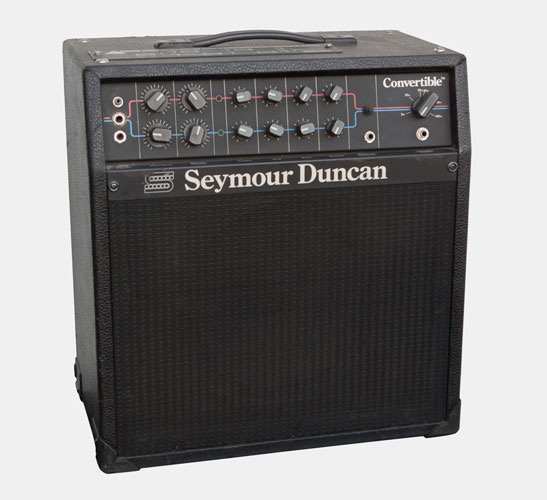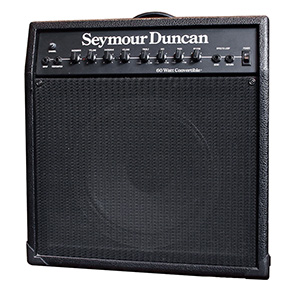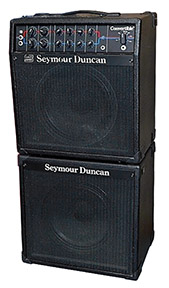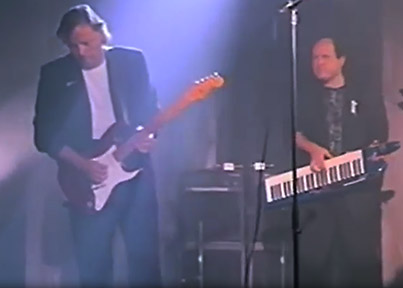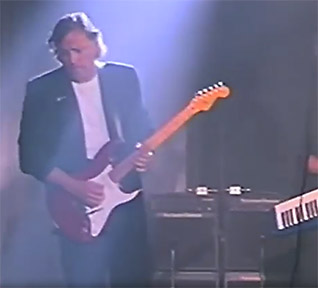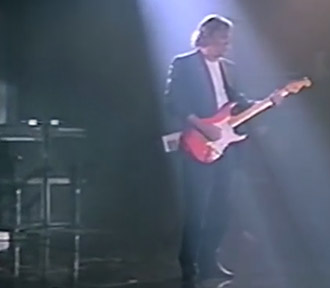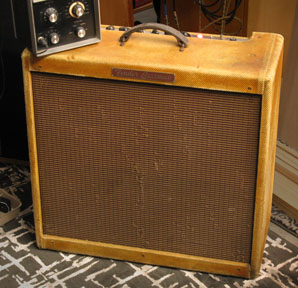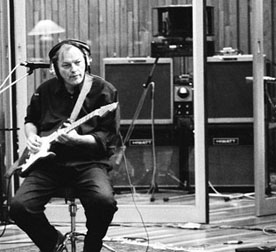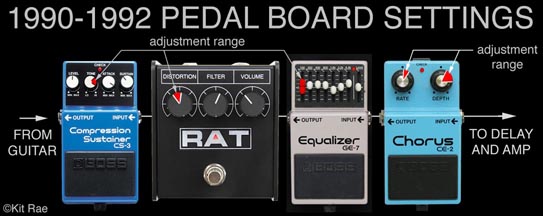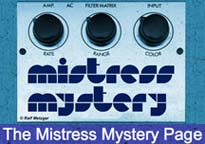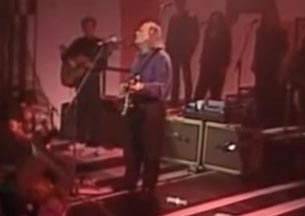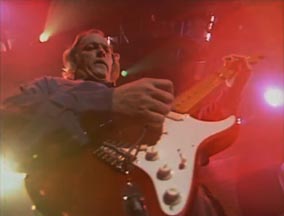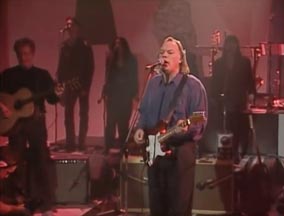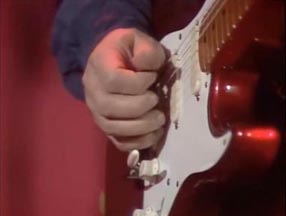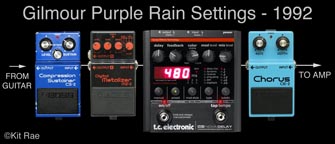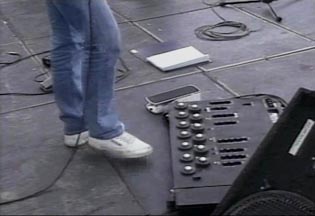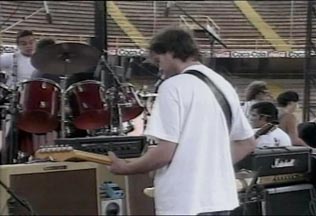NOTE: This website is frequently updated. Last update May 2024.
I did a lot of things. I was bored - and flattered to be asked. Some of the things I don’t have a lot of affection for, and some I’ve never even heard. With Grace Jones, I’m on one version of Slave to Rhythm, but I can’t really hear myself on it. I can become a perfectionist when I’m with Pink floyd, but going in, doing a guitar solo and then leaving is great. - David Gilmour on his session work for other musicians, from Total Guitar
1988-1992 STEREO RIGS AND SESSION WORK - From 1988-1992 David did over 30 sessions, performing guitar on other musicians songs. He typically used a stereo rig with two or more combo amplifiers. The first version of this rig began in 1987 and included a pair of Seymour Duncan Convertible amps. David used that rig for his Saturday Night Live appearance in 1987 and his performance with Les Paul in 1988. For his sessions with Paul Young for the song Heaven Can Wait in 1990 and for his guest appearances in John Martyn's band for the Apprentice tour in 1990, he used a slightly different setup. A Hiwatt SA-212 combo was added on top of the Convertible amps, with an MXR Digital Delay System 2 and Alembic F2-B preamp stacked on top of the Hiwatt. Some of the sessions in 1987-88 probably used the Boss HM-2 or Gallien Krueger 250ML from the 1984-1987 period for his lead tone, but I think most of these used a simpler pedalboard with a Proco Rat.
The Seymour Duncan Convertible 100 combo amp, 60 Watt Convertible, and a 100 stacked with the 1X12 Convertible extension cab
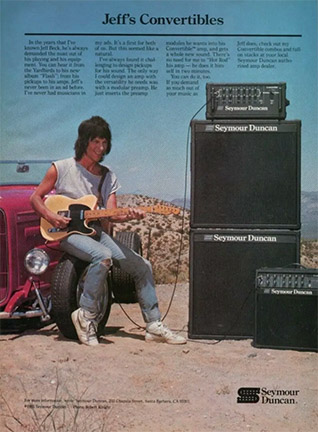
The Seymour Duncan Convertible magazine ad with Jeff Beck
The Convertible amps had been around since the early 1980s, with the first well known user being Jeff Beck. The line was discontinued in the early 1990s. The Convertible 100, a flagship amp for the line, was a two-channel amp and the first amp to feature power scaling. It could be set from 1 watt to 100, but its key feature was the switchable preamp modules that could be inserted into the five module slots on top of the amp. This was cutting edge technology for the time. The 100 came with modules for Hi-Gain, Normal, and Presence, and included a built in reverb tank. There were also modules for Classic Distortion, Low Cut Classic, High-Gain Hybrid, FET, IC, among numerous others. It allowed the user to customize different preamp and gain stages, so you could make it sound like any amp you wanted, in theory.
David used Convertible 100 combos, a 60 Watt combo, and two Convertible 1x12 extensions speaker cabinets. The modules David used are unknown, but presumably he had the amps set for a clean Fender or clean Mesa/Boogie tone, as with his previous and later rigs. One particularly good example of David using these amps in stereo was his appearance with Les Paul for the Les Paul & Friends television special, recorded at the Brooklyn Academy of Music Majestic Theatre in New York City on August 18th, 1988. David played this performance the day before ending his 1988 Pink Floyd tour with five concerts at the Nassau Coliseum in New York.
David playing through a Seymour Duncan Convertible 100 combo amp and 60 Watt Convertible, both stacked on top of two 1X12 Convertible extension cabs.
Note the Boss DD-2 delay pedal on top of the right amp and Boss CE-2 chorus pedal on top of the left amp, which was often a staple of these stereo rigs.
This is from his Les Paul & Friends live performance from August 1988.
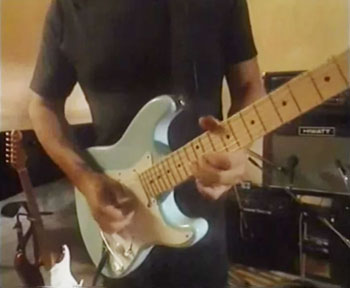
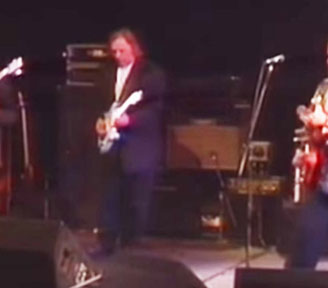
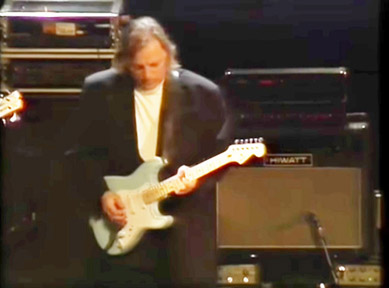
The second version of David's 1990s stereo rig - two Seymour Duncan Convertible 100 amps and a Hiwatt SA-212. An MXR Digital Delay System 2 and Alembic F2-B
preamp are stacked on top of the Hiwatt. David is playing an Eric Clapton Strat in the Paul Young session (left image) and in John Martyn's band (middle and right images)
David played a stellar blues jam at the Les Paul gig using his red EMG Strat, a small pedalboard, a Boss DD-2 going to one amp, and a Boss CE-2 chorus going to the other. The overdrive sounds like a Proco Rat + a Boss GE-7, with a short slapback delay. The music for the song is just an untitled generic blues chord progression, but over the years it has been referred to by the title Deep in the Blues. I remember bring blown away with the guitar tone and playing at the time, and stuggling to get a similar guitar tone.
![]() Deep in the Blues - David Gilmour with Les Paul excerpt
Deep in the Blues - David Gilmour with Les Paul excerpt
David's pedalboard was also simplified in this period. He used a small board that included a Boss CS-3 compressor, ProCo Rat, Boss GE-7 (or sometimes two) for adjusting the mids and bass of the Rat, a stereo Ernie Ball volume pedal, a Boss CE-2 chorus, and what appears to be a Cornish line driver. A second Boss CE-2 was often seen placed in between the amps, under the MXR delay. A boss DD-2 was also sometimes placed on or between the amps, and on one occasion there was a separate DD-2 going to one amp and a CE-2 ging to the other.. The first time I remember seeing this small pedalboard was in the Smoke on The Water session video for the Rock Aid Armenia charity in 1989, but it was likely used in the 1988 sessions as well.
GETTING DAVID'S DEEP IN THE BLUES TONE - This a stereo setup going to two amps, a 59 Fender Bassman reissue and a Twin Reverb. I use a Strat with EMG-SA neck pickup, SPC control off, and EXG control off. Pedals are a Boss CS-2 compressor, ProCo Rat, and a Boss GE-7 equalizer. The delay time is 300ms using a Future Factory stereo delay going to both amps. There is another short single repeat delay going to one amp. This creates a slapback or ADT effect, thickening the sound and helping separate the steroe field between the two amps. A Boss CE-2 chorus goes to the other amp, which also helps with the stereo effect.
Below is a tone build video demonstrating this setup, along with an alternate setup to get a similar blues tone using a Boss SD-1 Super Overdrive into a Boss HM-2 Heavy Metal pedal.
Later in 1990 the Convertible amps were dropped in favor of two 59 Fender Bassman combo amps, which Fender reissued that year. David bought two for his live rig and studio work. The Bassman was one of Fenders all-time classic amps, originally built in 1952. It was so popular that Marshall knocked off the circuit with their JTM-45 "Bluesbreaker", with 12" speakers instead of 10". The Bassmans were blended with David's Hiwatt combos for The Division Bell recording sessions in 1993. I own a 59 Bassman LTD and it is probably my favorite amp. It has a classic Fender clean tone, takes pedal very well, and works for just about any era of Gilmour's guitar tones.
The Fender 59 Bassman LTD reissue with Eminence blue frame alnico speakers, and David's 1990s rig with two Bassmans and two Hiwatt SA-212 combos
On a few occasions the Bassmans were stacked on top of two Hiwatt SA212 50 watt combos, one Fender/Hiwatt combo stack on the left, and one on the right. An MXR Digital Delay System II rack unit usually sat in the middle, on top of the amps, and a Boss CE-2 chorus was in line going to one of the combo stacks, giving it a stereo sound. The first time I remember seeing the four amp version of this stereo setup was the Cali, Colombia 1992 concert, with the two Bassmans and two SA212 Hiwatts. David used this same stereo amp setup for the 1993 Division Bell recording sessions.
There are not many photos from this period where David's actual pedal settings can be seen clearly, but below are general settings that work for most of the high gain lead tones, neck pickup overdrive, and clean tones. David likely changed his settings to suit the need, and you can use a different tone setting on the rat and GE-7 to create the same sound as the settings below. Simply changing the tone knob on the CS-3 and moving the 100Hz (far left) slider up or down on the GE-7 allows for a wide range of tonal adjustment.
That pedal board is actually very versatile. The CS-3 compressor included a tone knob that was great for fine tuning the treble going into the Rat, and GE-7 was used to sculpt and fine tune Rat tone. Using the bridge pickup on the guitar, the Rat and GE-7 can be dialed into a Big Muff type sound. The Rat is very mid range heavy, as is the Hiwatt SA-212, so the GE-7 was likely used to cut the mids, and sometimes boost the bass. Using the neck pickup of the EMG Strat into a clean Fender amp, the Rat creates a beautiful blues tone. Along with the GE-7, the Rat sounds very similar to the BK Butler Tube Drivers David would later use for his neck pickup leads. Using just the CS-3 and CE-2 with some delay into a clean Fender or Hiwatt nails David's clean neck pickup tones from this era.
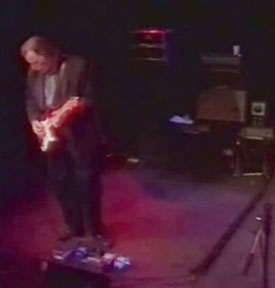
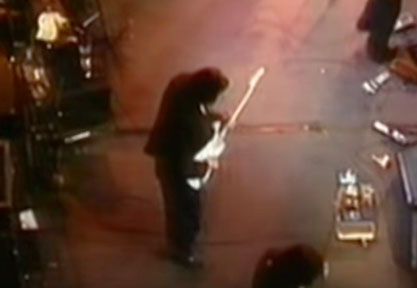
David standing next to his 1990 pedalboard
There are two unidentified boxes on the pedal board. One is probably a bypass switch for the MXR digital delay and the other is possibly a line driver. Presumably the two outputs of the stereo Ernie Ball volume pedal go to each of the left and right amps in the two amp version, but it is not clear how the signal chain was setup in the three and four amp version. There were several ways to make this setup "stereo," but the simplest one David used was to run a second Boss CE-2 chorus to only the stack on one side. A CE-2 was almost always seen in between or on top of the amps. A Boss DD-2 digital delay was seen on top of the amps in some performances, and the DD-2 has two outputs for stereo, so that may have been another way David split the stereo signal. David may have also used a Y splitter cord, or daisy chained one channel of a Bassman to the Hiwatt input on each stack, or vise versa.
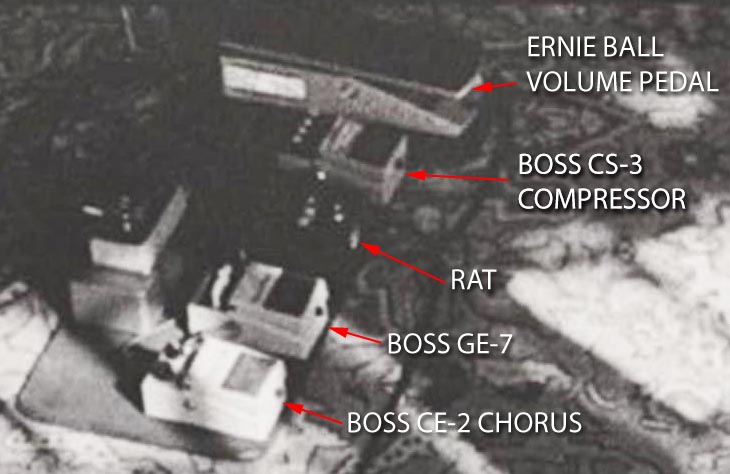

David's simplified 1990 pedal board seenon his floating recording studio, the Astoria (left) and in John Martyn's band (right)
Variations on this rig were used extensively for David's many guest guitarist appearances on other musicians recordings and numerous benefit and charity concerts from 1988-1992. This is just a partial list of those session recordings and live performances:
Deep in the Blues - with Les Paul. (1988) This may be David's HM-2 + Mesa/Boogie rig, but it sounds like the Rat rig to me.
You Never Listen to Me - Peter Cetera. (1988)
I'll Be In Love, This Feeling - Sam Brown. Guitar (1988)
Only One Word - Propaganda. (released 1990 but probably recorded 1988)
No Victims - Krist MacColl. Guitar Heroes Mix (1989)
Run Straight Down - Warren Zevon. (1989)
Smoke on The Water - Rock Aid Armenia. Guitar (1989)
Can't Let Go - Vicky Brown. (1989)
Flowers in the Dirt - Paul McCartney. (1989)
Como El Agua - Roe. (1990)
Only One World - Propaganda. (1990)
Running Up That Hill (cover), Alive - Blue Pearl (1990)
Understanding Women - Elton John. (1990)
Sasha - Michael Kamen. (1990)
Heaven Can Wait - Paul Young. (1990)
Are You Lonely - All About Eve. (1991)
Stone Cold - The Law. (1991)
Wishing The Hours Away, Wishing The Hours Away - All About Eve. (1991)
Hey Joe - David Gilmour with Seal - Live at the Amnesty International's Big 30 (December 1991)
On the Turning Away - David Gilmour - Live at the Amnesty International's Big 30 (December 1991)
Rock Me - Donovan. (1991)
Once, Once In The Middle Of Nowhere, Berliners, Burn the World - Roy Harper. (1990)
Purple Rain - live with Tom Jones band (1992)
Way's To Cry - John Martyn. (1992)
Waiting For The Sunshine, Only Love (Can Bring Us Home) - Jimmy Nail. (1992)
Standin' Around Cryin - Paul Rodgers. (1992)
I Put a Spell on You - live with Mica Paris, on Jools Holland's Mr. Roadrunner television Series (June 1992)
In a Broken Dream - Rod Stewart. (1992)
ECOMUNDO 92 concert in Cali, Columbia, South America - Gilmour performed 4 songs with the house band, and 5 with Roger Daltry (December 4th, 1992)
There are numerous examples of David's stellar playing using this setup , like Warren Zevon's Run Straight Down from 1989, I Put a Spell on You with Mica Paris in 1992, and many others. Here is a 14 minute medley of different Gilmour guitar solos from the 1980s and early 1990s, many of which sound like exactly the same setup. Here is the Song List in the order they are heard.
![]() Gilmour Guest Solos from the mid 1980's - early 1990's.
Gilmour Guest Solos from the mid 1980's - early 1990's.
Most of the time David was using the bridge pickup with this setup, but occasionally he used the neck pickup on songs such as the version of I Put A Spell On You he played with Mica Paris and Jools Holland. This setup sounds great with either pickup, but I suggest turning the guitar volume down slightly and adding a compressor when using the neck pickup.
1991 - AMNESTY INTERNATIONAL BIG 3-0 - David Gilmour, along with Jools Holland, was the musical director for the Amnesty International Big 3-0 anniversary TV special, featuring numerous guest musicians. The concert aired in August 1991. David played guitar with several performers, including with Tom Jones, a rocking performance of Hey Joe with Seal, a performance of On the Turning Away with his house band, and bass guitar on Big Bottom with Spinal Tap. He used his red EMG Strat, two Fender Bassman amps, his small Boss/Rat pedal board, an extra Boss CE-2 going to one Bassman, an MXR Digital Delay System II rack unit, and a Zoom 9030 multi effects unit on top of the MXR. The distortion for his lead tone on Hey Joe sounds like the Rat. I'm not sure what he used for On the Turning Away.
It is not known how David used the Zoom unit, but it had several stereo chorus effects, delay, and reverb effects that David may have used. The Zoom came out in 1991 and became one of David's favorite pieces of gear to use for making demos. He played a Gibson J-200 guitar through one with an ebow to create the intro sounds of the song Take It Back from the Division Bell album.
Below are excerpts of the guitar solos from the Amnesty performances.
![]() On the Turning Away Guitar Solo 1991
On the Turning Away Guitar Solo 1991
David performing On the Turning Away
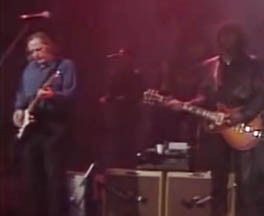
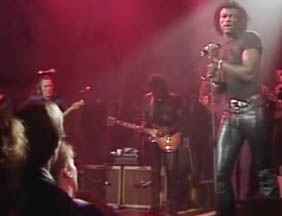
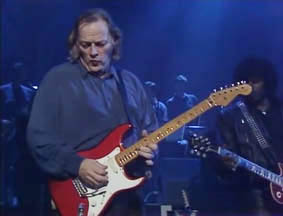
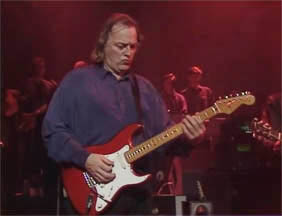
David performing Hey Joe with Seal
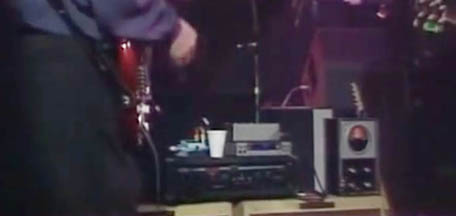
Boss CE-2 chorus, Zoom 9030 Multi Effects unit, MXR Digital Delay System II, and a Conn Strobo tuner on top of the Bassman amps

The Zoom 9030 Multi Effects processor
GETTING DAVID'S HEY JOE TONE - This one is similar to the 1990-1992 STEREO RIG settings shown above. I use a Strat with EMG-SA neck pickup, guitar volume on 7, SPC control on maximum, and EXG control off. Pedals are a Boss CS-3 compressor, ProCo Rat, Boss GE-7 equalizer, Boss CE-2 chorus, and a TC Nova Delay going into a Fender Bassman reissue. The delay time is 440ms, tone dialed to a clean digital sound, around 7 repeats, with the delay volume relatively high. David actually used two CE-2s for this song, the one on his pedalboard that was going to both Bassmans, and one in front one of the Bassmans to enhance the left/right stereo field.
You can also use a Tube Driver instead of the Rat to get a similar tone. This clips is the same setup as above, but with a 1980s Tube Driver.
![]() Hey Joe with BK Butler Tube Driver
Hey Joe with BK Butler Tube Driver
GETTING DAVID'S ONTHE TURNING AWAY TONE - This one is similar to the settings shown above, but I think David had the CE-2 chorus on his pedalboard switched off, so you only hear the second CE-2 that was going to one Bassman. That means the chorus was only about 50% in the mix. You can do that with one amp by running the CE-2 through a looper pedal with a mix knob, like the Boss LS-2, or use a Boss CE-2B, which has a mix knob. I use a Strat with EMG-SA bridge pickup, guitar volume on maximum, SPC control on maximum, and EXG control off. Pedals are a Boss CS-3 compressor, ProCo Rat, Boss GE-7 equalizer, Boss CE-2 chorus (50% in mix), and a TC Nova Delay going into a Fender Bassman reissue. The delay time is 580ms, tone dialed to a clean digital sound, around 5 repeats, with the delay volume relatively high.
1991 - LA CARRERA PANAMERICANA - In December 1991 Pink Floyd recorded the soundtrack for La Carrere Panamericana, a film broadcast on the BBC in December 1991. It documented David and Nick Mason's journey in the 3000 mile South American car race. The music was mostly existing and reworked Pink Floyd material. It was released on VHS video in April 1992. David again used his small Boss/Rat pedal board and his Bassman amps. The rig can be seen in session photos from Phil Taylor's excellent book, The Black Strat.
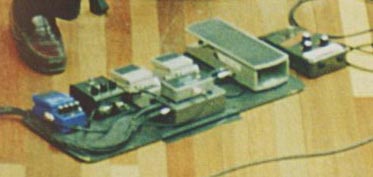
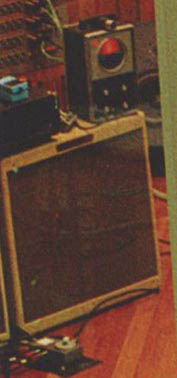
David's Boss/Rat pedal board and one of the two Bassman amps used for the La Carrere Panamericana recording sessions at Olympic Studios in December 1991. Note the Boss CE-2 and MXR Digital Delay Sustem II stacked on top of the Bassman. The unplugged pedal to the right of the volume pedal is a Colorsound Overdriver.
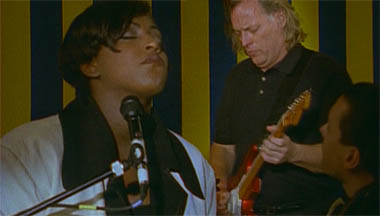
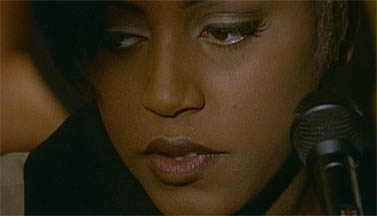
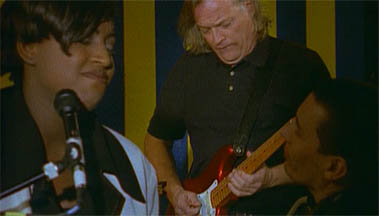
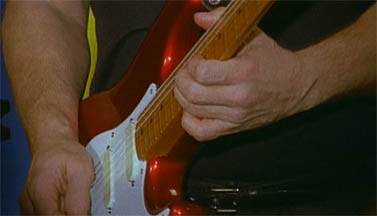
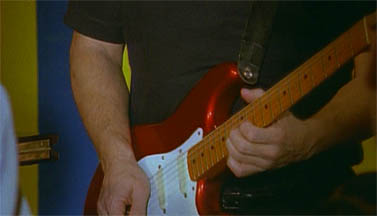
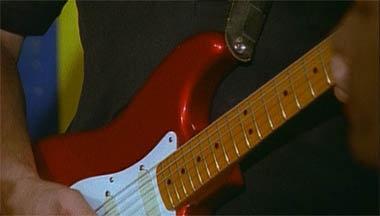
1992 - I PUT A SPELL ON YOU LEAD TONE - Gilmour played some fantastic blues guitar on a version of I put A Spell On You with Mica Paris, recorded in 1992 for Jools Holland's Mr. Roadrunner television series which aired in June 1992. The video performanc eof this song can be found on the David Gilmour In Concert DVD (2002). He played his red Strat fitted with EMG-SA pickups. The effects and amp used are unknown, but almost certainly it was the same stereo rig he had been using throughout 1992 - two Bassmans, or two Bassmans and two SA-212 Hiwatts, with a Boss CE-2 chorus going to one side and an MXR Digital Delay rack unit. He would have used the same Boss/Rat pedal board from this period, which included a Boss CS-3 compressor, ProCo Rat, Boss GE-7 (or two) for EQ'ing the Rat, Ernie Ball volume pedal, and a Boss CE-2 chorus.
I think all he used here was the Rat going into his Bassmans. This was one of the last times he used a Rat for an overdrive before switching to the B.K. Butler Tube Driver. Here is a link to Gilmour's guitar solo.
![]() I Put A Spell on You solo - David Gilmour 1992
I Put A Spell on You solo - David Gilmour 1992
GETTING THE TONE - This one is a relatively simple setup. I used a Strat with EMG-SA neck pickup, Boss CS-3 Compressor, and a ProCo Rat going into a Fender Twin Reverb. No chorus or delay needed. It sounds even closer going into a Fender Bassman.
![]() I Put A Spell on You with ProCo Rat
I Put A Spell on You with ProCo Rat
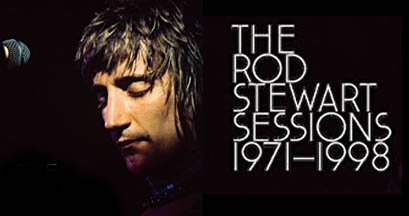
1992 - IN A BROKEN DREAM LEAD TONE - In 1992 Rod Stewart recorded a remake of In A Broken Dream with John Paul Jones (of Led Zeppelin) and David Gilmour. Although the track was recorded in '92 it remained unreleased until the 2009 boxed set The Rod Stewart Sessions 1971-1998. The gear Gilmour used is unknown but it is almost certainly his typical 1992 rig of his red '57 reissue Strat fitted with EMG-SA pickups through a Rat, into a stereo rig of two Bassmans or two Bassmans and two SA-212 Hiwatts. His effects at the time were an MXR Digital Delay rack unit, Boss/Rat pedal board with Boss CS-3 compressor, ProCo Rat, Boss GE-7 (or two) for EQ'ing the Rat, Ernie Ball volume pedal, and a Boss CE-2 chorus going to one of the stereo amp channels.
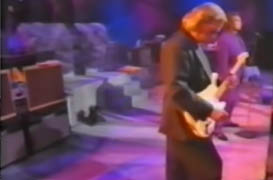
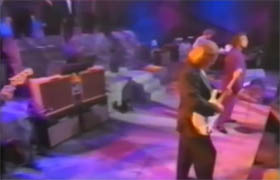
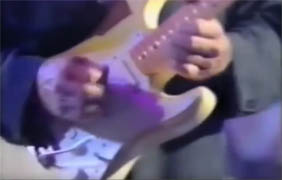
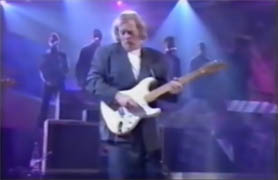
1992 - PURPLE RAIN LEAD TONE - In 1992 David Gilmour joined Tom Jones' band for an episode of Tom's television special called Tom Jones: The Right Time, which aired on June 13th. It was a six episode series broadcast on ITV in the United Kingdom and on VH1 in the United States. David played on a cover of the Prince song Purple Rain, with a very moving 3 minute guitar solo. David incorporated a few of the phrases from Prince's original, but the majority of the solo was pure Gilmour improvisation. Here is just the solo section of the performance.
![]() Purple Rain solo - David Gilmour 1992
Purple Rain solo - David Gilmour 1992
David is playing his 1980s cream Strat with EMG-SA pickups, using the bridge pickup only. His amps were the typical stereo setup from this period - two Fender Bassman combos stacked on top of two Hiwatt SA212 combos. The setup was likely a Boss CS-3, Rat, and a Boss GE-7. Although he was using his small Boss/Rat pedal board around this time, I'm not so sure this is a Rat. David had a Boss MZ-2 Metalizer on his pedal board in 1990 and again in 1994, and he may have used that here. The MXR Digital Delay System II is resting on top of the Bassmans in the middle. A Boss CE-2 chorus and what appears to be a Boss DD-2 Digital Delay are stacked in between the amps, on top of David's Conn Strobo tuner. All delay sounds like it is in the left channel only but the chorus effect is very dominant in both channels. I think the MXR delay was running to both left and right amps, and the DD-2 was only going to the left amps, set for a slightly longer delay time.

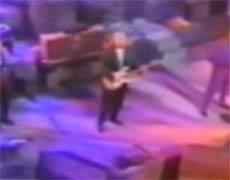
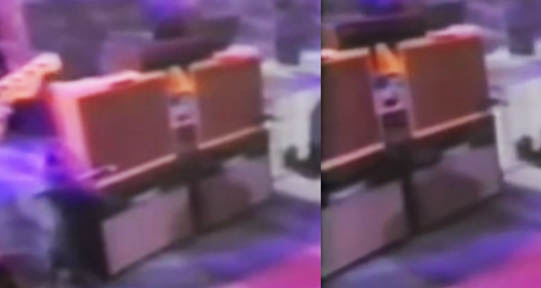
GETTING THE TONE - Despite the very un-Gilmourish 'Metalizer' name, the MZ-2 is actually very underrated Gilmourish sounding distortion pedal. It works well for late 1980s-early 1990s Gilmour tones all on its own, without needing to blend with boosters or overdrives like the Boss HM-2. Here are clips of my MZ-2 setup using a Strat with EMG-SA pickups, bridge pickup only, into a Fender Twin Reverb. Effects are a Boss CS-2 compressor set for a light boost, Boss MZ-2, TC Nova delay set for 480ms and a digital delay tone, and a Boss CE-2. Settings shown below.
Below is an alternate setup without the compressor, but adding a light overdrive after the MZ-2 with a BK Butler Tube Driver. It is a bit smoother sounding, but the chorus effect is not as up front.
Below is a clip using a Proco Rat, which was another commonly used Gilmour pedal from this period. It was alwasy EQ'd by a Boss GE-7.
1992 - ECOMUNDO 92 - Gilmour performed a benefit concert in Cali, Columbia, South America on December 4th, 1992. He played four of his own songs, then played guitar on five Who songs with Roger Daltry of The Who. David used a Pete Cornish pedal board that originally belonged to Martin Kemp of Spandau Ballett. It had been completely re-worked by Pete in 1988 and included the following effects: MXR Dynacomp, Cornish SS-2, EHX Big Muff, EHX Electric Mistress, Boss CE-2, Boss DD-2, Boss SP-1 (replaced with a GE-7 in 1993), and a Cornish NB-2 Booster. It was used for the Division Bell recording sessions in 1993, and Cornish made some more modifactions in 1993 and 1994.
(left) Screen caps of Phil Taylor setting up David's Pete Cornish pedal board (that once belonged to Spandau Ballet) and David's Bassman amps with MXR Digital Delay System II on top. Note the Boss CE-2 on top of the Conn Strobo tuner, placed between the amps.
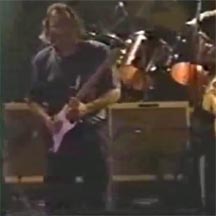
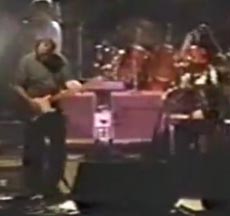
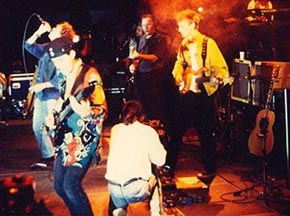
Kit’s Secret Guitar, Gear, and Music Page
Guitar stuff, gear stuff, soundclips, videos, Gilmour/Pink Floyd stuff, photos and other goodies.
Copyright Kit Rae.
VISIT MY SWORDS, KNIVES and FANTASY ART WEBSITE www.kitrae.net

